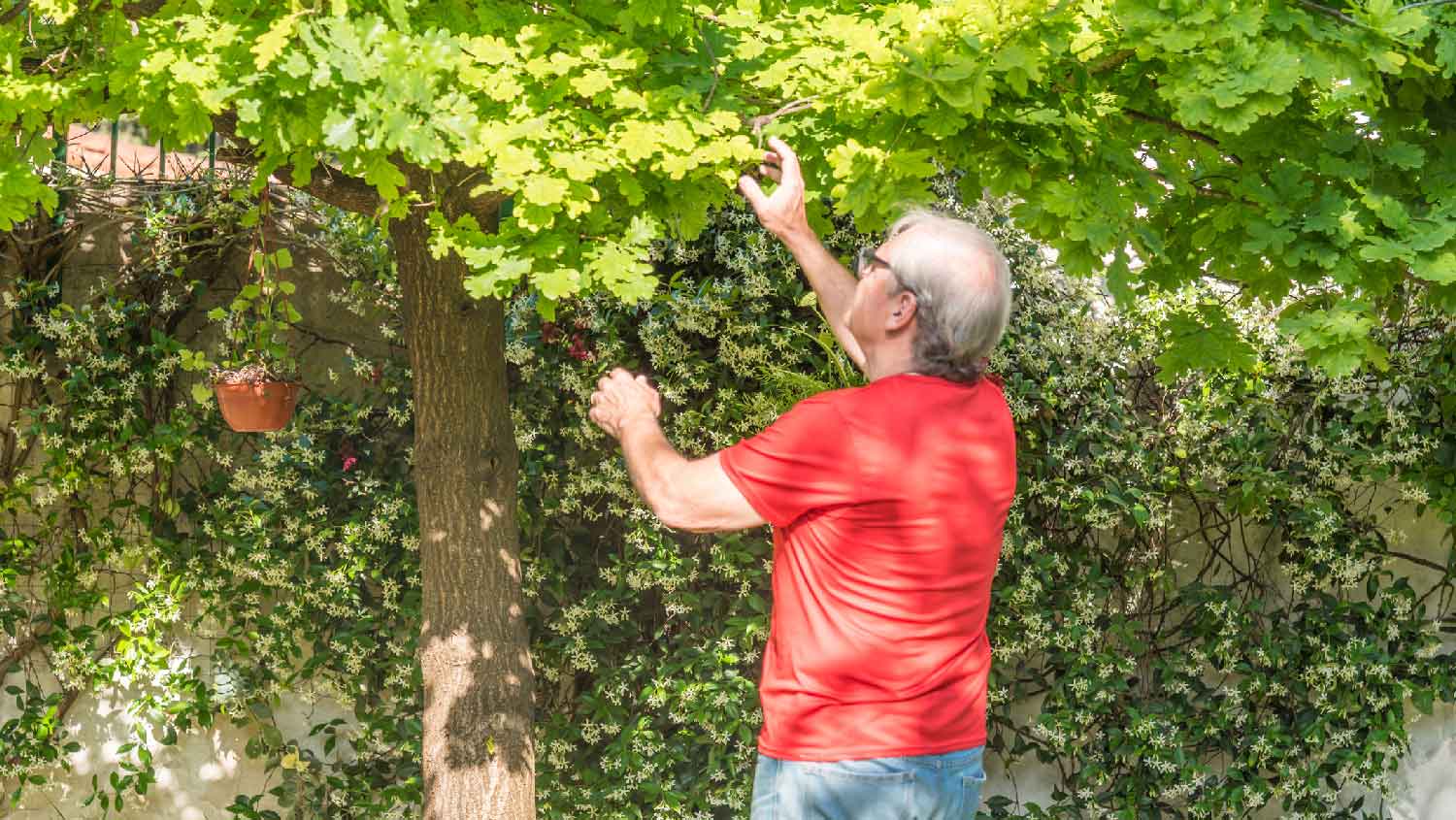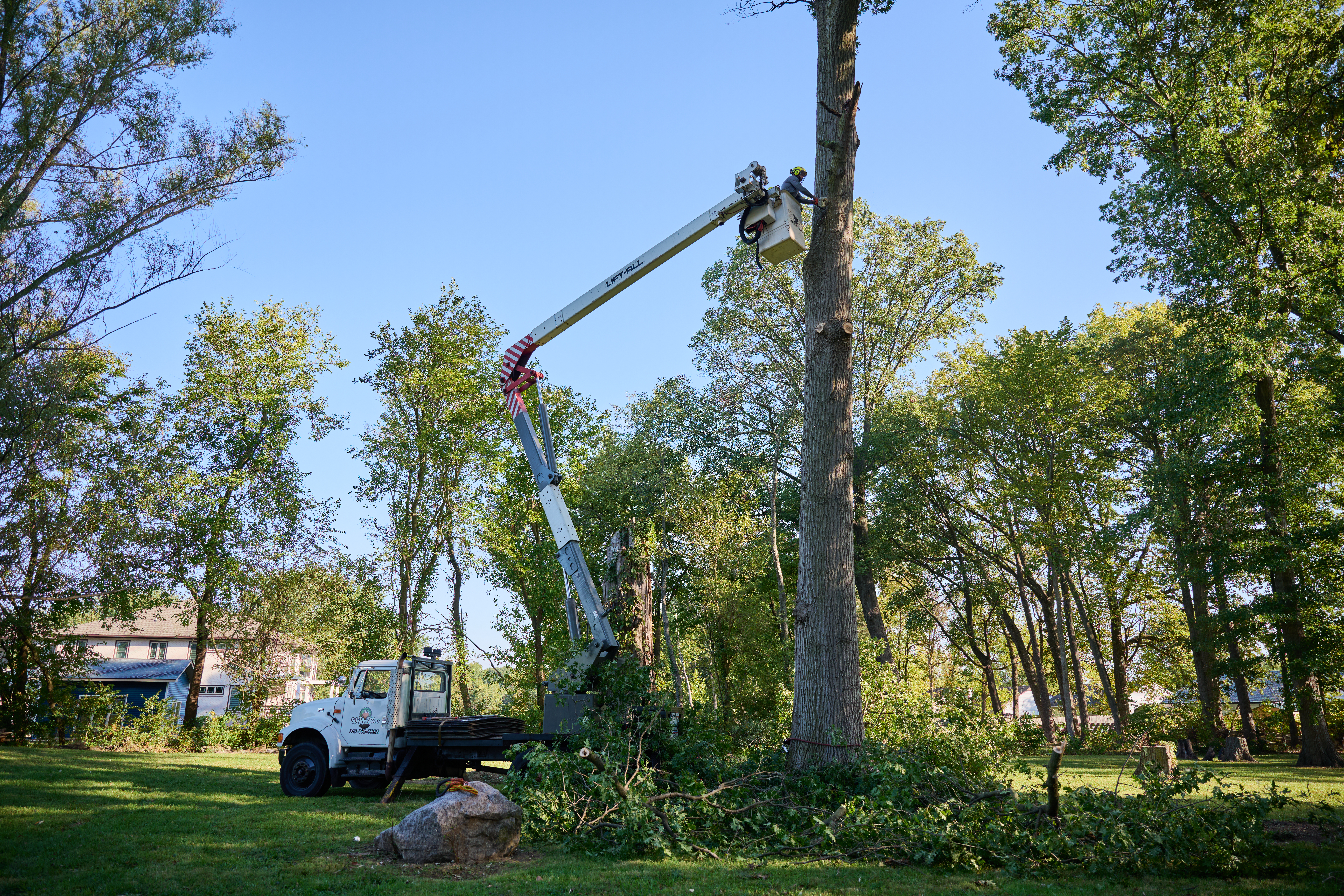
Trimming your bushes is one of the less costly aspects of landscaping, and it’s helpful to bundle many trimming services together to save money.
From bugs to droughts, here’s what can take down a tree


Diseases like Armillaria root rot can weaken and kill trees.
Trees often die from natural disasters like heat waves, droughts, floods, and fires.
Human error, including soil compaction and pesticide runoff, also destroys trees.
Why do trees die? Trees can seem indestructible, especially once they’ve grown thick trunks to weather the elements. But while trees are naturally hardy, they can be taken down by threats like diseases, pests, and natural disasters—even if it takes years for them to die. Our guide breaks down nine common causes of tree death that homeowners should be on the lookout for.
Some tree diseases affect certain species, like Dutch elm disease and Chestnut blight. Others, such as Armillaria root rot and anthracnose (a group of fungi that destroy leaves), are notorious for killing many types of trees. These diseases have one important thing in common: They attack a vital part of the tree that’s necessary for survival. As a result, the tree can no longer manufacture and carry nutrients and water through its fibers. No matter how resilient the tree is, that usually spells a slow but sure death sentence.
Even if the disease doesn’t kill the tree, it may weaken it so it’s more susceptible to the other scourges discussed below.
If a disease is caught early enough, you may be able to save the tree. A local tree maintenance professional will be able to diagnose the problem and determine if it can be treated.
Some trees, such as birch, cypress, and willows, need lots of water. But even an established, drought-resistant tree like a bur oak will eventually start to suffer after a prolonged dry period.
Most trees don’t like to be waterlogged, either. Excessive moisture impedes their nutrition system, kills off leaves or needles, and can eventually destroy their roots.

The powerful defenses of trees make it difficult for pests to do too much damage. But there are a few exceptions, including:
Large swarms of insects like locusts or certain species of caterpillars like gypsy moths can devour most of a tree’s leaves (this is known as defoliation), which halts the tree’s growth. Trees have to spend significant resources to survive; weaker trees will often die within a couple years.
Bugs like pine beetles can burrow into a tree’s bark in large numbers. Trees with damaged bark can eventually die, especially if a fungus finds its way inside. Pine beetle larvae can also damage tree roots, compounding the problem.
Insects like emerald ash borers and Asian long-horned beetles eat into bark to lay eggs, and their larvae actively eat softwood and sapwood. This hinders a tree’s ability to transport moisture and nutrients, eventually leading to its death.
Bugs like spider mites actively suck out nutrients in trees like junipers, spruces, and hemlocks, and they sometimes inject toxins in the process. In large numbers, spider mites weaken trees enough for them to succumb to environmental problems or disease.
Certain insect species do little damage on their own but carry fungus spores on their bodies as they enter trees. That’s how oak wilt often spreads to trees.
In addition, animals like deer will chew off tender stems and shoots. This can weaken and destroy young saplings before they have a chance to develop tougher protections.
Competition is very real in the world of trees. Saplings often die because they’re growing too close to the canopy of another tree and can’t get enough sunlight. Nearby trees can also take up water and nutrients that saplings need to survive.
Soil compaction occurs when trees are planted on a property and backfilled improperly, or when well-meaning homeowners landscape around trees, add new soil, and then compact it. This can crush important roots near the surface. Compacting the soil also pushes out air, essentially suffocating the soil and nearby roots.
Heat waves and deep freezes pose dangers to trees that aren’t prepared to deal with them. High temperatures can quickly dry out trees and scorch leaves. This is especially true if an area experiences an unusual heat wave that trees haven’t experienced before.
While some trees develop protection against freezing weather, extremely cold temperatures can be deadly. Sub-zero temperatures can freeze the sap in some trees and cause cracking.
Fires are a broad natural disaster, but they have special implications for trees. Trees are often flammable, from their leaves to their sap, so they may catch fire more easily than surrounding materials—especially if they’ve been hit by a drought first. While some trees develop thick bark to survive milder grass fires, a fire is still a traumatic event for any tree and often leads to death.
High levels of air pollution can slowly poison trees via their carbon dioxide exchange system, inhibiting growth and shortening their lifespan. Another type of pollution called phytotoxicity occurs when trees are poisoned from the runoff of industrial fertilizers, pesticides, or chemicals—or even well-meaning fertilization by homeowners. This destroys leaves and needles and may eventually kill the tree. In addition, floods and other natural disasters can expose trees to salt water or polluted water that can quickly kill them.
Trees live a long time—along with fungal networks, they’re the oldest living thing on the planet. Most trees live for 100 to 400 years, and certain species in certain spots can live for thousands of years. But their lives do eventually come to an end.
As trees age over many years, their deadwood builds up, and flaws can open up in their bark. Think of how humans start to wrinkle and lose bone density, except it usually takes trees longer. As trees weaken, they become more vulnerable to pests and diseases, and decay eventually overcomes them.
From average costs to expert advice, get all the answers you need to get your job done.

Trimming your bushes is one of the less costly aspects of landscaping, and it’s helpful to bundle many trimming services together to save money.

The most significant factor in tree removal costs is the amount of debris. Read on to learn more about the average tree debris removal costs.
Get transparent shrub removal cost info. Learn average prices, key cost factors, and tips to save on your next shrub removal project.

Don’t get ripped off when hiring a professional tree service to remove trees. Make sure you watch for these scams that occur much too often.

Learn what a maple tree looks like, whether you want to make your neighborhood walks more entertaining or find trees suitable for your yard.

Moving your favorite tree isn’t exactly a small task, so we’ll break down some common tree transplanting costs so you can be prepared.